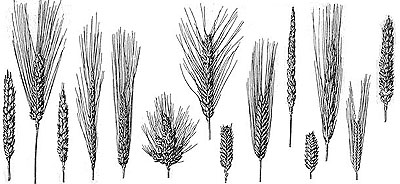Domestication
- page 2 -
In the Near East, many varieties of the wild cereal grasses, wheat and barley, shown below were exploited as major food sources.

The act of harvesting the wild grains changed them genetically. For example, a small percentage of wild grass plants has seed that clings to the stalk even when ripe, rather than separating easily. Humans collecting wheat or barley seed would succeed in gathering a disproportionate amount of the mutant seeds-that-cling in each harvest. Thus, the seed they sowed the next year would gradually increase the amount of seeds-that-cling in the next crop. Over time, the percentage of wheat and barley seed that falls off the stalk when ripe declined--which made harvesting much easier. In this way, these crops were "domesticated" to the point where they cannot reproduce themselves without human intervention. Other qualities, such as the size and number of the kernals, also changed over time, due to human activities.

